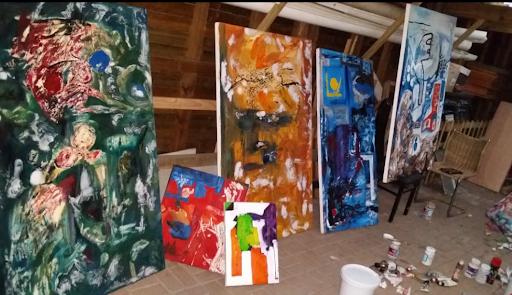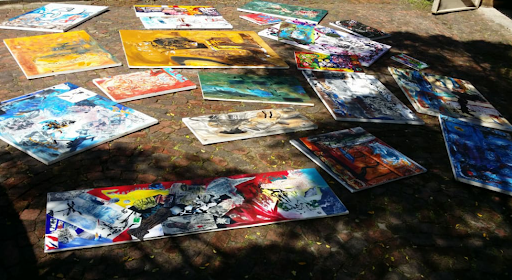new arrivals September 2020
Shelton Hu
Shelton Hu (b.1996) is a young South African artist based in Knysna in the Western Cape. Born in the Free State to Chinese parents, Hu’s work communicates in a global lexicon as he draws on influences from Eastern traditions, Western practices and is further inspired by elements from the African diaspora.
In this Q&A, Shelton sits down (virtually) with Marisha Flovers to discuss his artistic practice.
Marisha Flovers: Hi Shelton, let’s start with telling our readers about your upbringing. Where did you grow up and attend school?
Shelton Hu: I was born in Bloemfontein in 1996, and grew up in Alberton, Johannesburg. I attended high school at the National School of the Arts from 2010-2014, where I majored in visual art. When I matriculated, I enrolled at the University of the Witwatersrand to continue my studies in Fine Art. I also spent a short amount of time studying in China, where most of my family still remain. At the moment, I am studying towards a PGCE at Wits.
MF: When did you first realise you wanted to become an artist?
SH: Preschool. I remember being asked by a teacher during preschool graduation, ‘What would you like to be one day?’ and my response was ‘to be an artist’.
MF: Your work is so visually stimulating. Where do you draw inspiration from?
SH: If I were to summarise it, my sources of inspiration are twofold: the experiences gained from our predecessors, and the creation of nature. The act of creating art itself serves as my biggest inspiration.
MF: Who are your favourite artists?
SH: I spend a lot of time studying artists and their artworks, as I view it as a crucial part of my practice. It shows me what is possible. I simply cannot mention a favourite, as I look to different artists for different genres and methods of working. There are too many to name, and the list is continuously expanding. I am drawn to artworks that are visually expressive and impactful. A few that come to mind are figurative artists Vincent van Gogh and Edvard Munch, German Expressionists Ernst Kirchner and Paul Klee, American Pop Artist Jim Dine. When it comes to abstract artists I am moved by the work of Willem de Kooning, Franz Kline, Zao Wou-Ki, David Smith and Chu Teh-Chun. Other artists that inspire me include Antoni Tapies and Robert Rauschenberg, Kikuji Kawada and Hiroshi Sugimoto, Huang YongPing, Cai GuoQiang and Joseph Beuys. In terms of South African artists, the work of Edoardo Villa, Cecil Skotnes, Bill Ainslie and Kagiso Pat Mautloa are all inspiring to me in some way. I will also mention Lionel Murcott and Karel Nel, who I was fortunate to study under.
MF: Going by your present body of work, you are very much an abstract painter, although you have worked figuratively, seen partly in the etchings we have up on our walls here at the Blue House on 151 Jan Smuts Avenue. What is it about abstract art that is so interesting to you and your practice of it?
SH: I first experienced creating abstract paintings in Grade 11, while studying at the National School of the Arts. I was encouraged by my teacher, Walter Daniels, to experiment with the genre. For my term project, I painted on a large canvas that measured around two metres in length. I see abstraction as the purest form of art, as it is essentially composed of the basic elements of art, yet abstraction allows art to transcend beyond reality and subject matter. Therefore, the possibilities are limitless. Abstraction may feel very distant from our daily lives, and yet it exists everywhere. From the brushstrokes and ink marks used in calligraphy, the rust on sheets of metal, patterns and designs on ceramics, textiles, and even in nature itself. It is purely a visual experience. Chinese culture has an ancient history when it comes to abstraction, even though the genre of ‘abstraction’ was a concept that came from the West. Initially, the Chinese did not have words which categorised abstract art. The characters ‘抽象’ were first used by the Japanese to describe things and art that are derived from its recognisable and figurative appearances. The characters that make up the Chinese language are all forms of abstraction. Many abstract painters from the West were influenced by Eastern philosophy and aesthetics.
MF: The influence of calligraphy is apparent in some of your paintings, through solid and deliberate ink-like strokes. Do you practice calligraphy? Why or how does it appeal to you?
SH: Yes I do. I enjoy the quality of writing with a brush, the calligraphic mark-making and the structural composition of Chinese characters. I also get to experience the subtle transitions of ink on paper. This creates different qualities, depending on the ratio of ink to water.
MF: Where might we have seen your work before?
SH: I haven’t really participated in exhibitions as of yet. The only group show I took part in was at BKhz Gallery last year. The owner, Banele Khoza, was kind enough to invite me to take part in an exhibition titled Process, in which other artists and myself used the gallery space as an open studio to create works. Other participating artists included Allan Laing, Mashudu Nevhuthalu, Sharon Moses, Matt Hazell, Ke Neil We, Chris Soal, Lady Skollie and Tatenda Chidora. Visitors to the gallery were welcomed to view our process of creation.
MF: Speaking of processes of creation, where is your studio?
SH: My studio is currently my garage at home in Knysna.
MF: When I spoke to artist Stephen Hobbs about the works you have up at our gallery, he mentioned how skilful they are, remarking on your dexterity and how it translates in your paintings. Do you spend a lot of time perfecting these painting techniques?
SH: I wouldn’t claim my techniques as skilful, but I do paint whenever I can. Almost every day, if time allows me.
MF: How has your style and technique changed over time?
SH: I started taking art lessons when I was eleven. At the time I was living in China, so I focused on learning traditional Chinese painting. However, I began painting in oils after I started high school at the NSA. On weekends I received art lessons from Lionel Murcott, who had just retired from the NSA at the time. He works in a very expressive manner and that influenced my mark-making in drawing and painting. Then, as mentioned earlier, I started studying and experimenting in abstraction and mixed media during my senior years in high school, and further at university. At the moment my practice draws on influences and traditions from across China, the West and our own continent of Africa.
MF: I have heard that you stretch your own canvases? Is it an important part of the process for you to do it yourself? If yes, then why?
SH: Yes, I make my own stretchers and stretch my own canvases, a skill I learned while studying at Wits. To be honest, I do it myself because it is cost-efficient. Also, many canvases sold at art stores feel like plastic, and the stretchers are made from bad quality timber. Art supplies and canvases cost too much these days.







